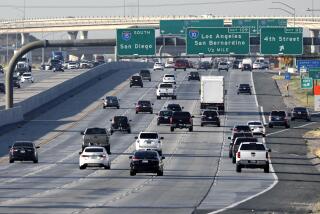To Explain Traffic, They Avoid It
- Share via
From Rudy Grande’s vantage, the afternoon commute doesn’t look all that bad. It is actually kind of pretty: a shimmering string of brake lights winking red along the Ventura Freeway through Sherman Oaks as a fiery sun sinks below the horizon.
Yet what is beautiful from a helicopter at 1,000 feet is, at street level, nothing more than yet another clutch-mangling, teeth-gnashing commuting nightmare.
As an airborne radio traffic reporter, Grande spots the bottlenecks and bumper-thumpers on Southern California freeways and helps drivers steer clear of them. Thousands of commuters--from San Bernardino rock ‘n’ rollers to Westside National Public Radio types--depend on Grande’s daily observations from on high to get them home in time for dinner. Or at least in time for, well, bed.
Especially in post-quake Los Angeles, where damaged freeways have turned commuting into a crapshoot, Grande and others like him act as eyes in the sky to warn drivers of trouble ahead and spy alternate routes.
“It’s different every day,” said Grande, who broadcasts live reports from the air an average of every two or three minutes during the morning and afternoon commutes. He works for Metro Traffic Control, the largest traffic reporting service in Southern California. “It’s a fun gig.”
*
The flight takes off at 4 p.m. sharp from Van Nuys Airport. As pilot Al Davis checks the gauges in his preflight routine, Grande dashes across the Tarmac, hops in the back seat of the Bell JetRanger and slams the door.
Seconds later, Davis lifts the aircraft off the ground and points it north toward the beleaguered Newhall Pass. As Davis chats with the airport tower, Grande slips on his headphones and adjusts the radio equipment.
In his lap rests a clipboard to jot down problem areas. Notes at the top of the page remind Grande of which of seven radio stations is carrying his broadcast at any given time. Over the next two hours, he constantly monitors the stations, listening for his cues and changing from straight man to funnyman.
Broadcasting for oldies station KRTH 101.1 FM, he remarks on the sunset, made blood red by a shroud of smog. But for public radio station KCRW 89.9 FM, his reporting is spare and tight. Same goes for his spots on news station KNX 1070 AM.
In the front seat next to pilot Davis, another Metro Traffic reporter, Jorge Jarrin, files dispatches in the same frantic pace for a handful of English- and Spanish-language stations.
With his laminated Thomas Bros. map spread across his lap, Grande, a former disc jockey from Albuquerque, peers down at the Santa Monica Freeway and looks for less-congested surface streets. He suggests Washington Boulevard on his next report.
It is a tricky business. Traffic is fluid and it changes from minute to minute. Because it is impossible to monitor all the freeways, Grande and other airborne reporters swap information over their radios. For instance, a reporter over the San Bernardino Freeway reports a tie-up, which Grande includes in one of his dispatches--even though he is over the Long Beach Freeway at the time.
“Notice,” he says, “I didn’t say I saw it. But somebody did.”
*
Back on the ground, Grande talks about the service he and other traffic reporters provide for commuters. “Maybe by listening to my report, someone will make it home a little less likely to kick the dog,” he said.
But a USC professor believes that the way Grande and others present their information reinforces aggressive driving attitudes.
“The atmosphere is like being in one of the those carnivals with bumper cars,” said Sandra Ball-Rokeach, a communications expert at the Annenberg School of Communications.
Though Ball-Rokeach does not argue that traffic reports make people drive like maniacs, she does believe that humanizing the reports could make motorists more careful as they drive.
That is fine for a classroom, Grande said. But from his vantage at the top of the world, the bottom line is telling freeway drivers how to get from here to there with the least hassle.
“I try to identify with the guy on the street,” said Grande, who, like everyone else, hates traffic jams. “What I would want to hear is what I’m going to say.”
More to Read
Sign up for Essential California
The most important California stories and recommendations in your inbox every morning.
You may occasionally receive promotional content from the Los Angeles Times.









